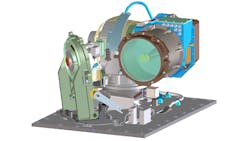NASA has relied on RF communication since its first mission into space. As data-capacity demands increase, however, RF is reaching its limits. To extend NASA’s capabilities, a new system uses lasers as opposed to radio waves for two-way communication. Such communications include increased image resolution and 3D video transmission from deep space. Dubbed Lunar Laser Communication Demonstration (LLCD), NASA’s new system recently proved its ability to transmit data between the moon and Earth.
This file type includes high resolution graphics and schematics when applicable.
In the demonstration, LLCD used a pulsed laser beam to transmit data over 239,000 miles from the primary ground station in New Mexico to the spacecraft. That spacecraft is currently orbiting the moon at a download rate of 622 Mb/s— the fastest to date. Being five times quicker than the data rate provided by currently used S-band communications, LLCD technology is capable of reducing the download time of an average-length movie from 639 hrs. to less than 8 min.
How It Works
By encoding data onto a beam of laser light, LLCD enables “optical communications” or the use of light as the medium for data transmission. Common uses of optical communications use the visible or near-visible portions of the electromagnetic (EM) spectrum. LLCD, however, operates in the near-infrared section in the form of a laser beam. Laser communications enables NASA to work within an unregulated, less-crowded section of spectrum.
Laser wavelengths also are 10,000 times shorter than RF wavelengths, allowing for data to be transmitted across narrower, tighter beams. These smaller wavelengths are more secure and can deliver the same amount of signal power to much smaller collecting antennas. The subsequent reduction in antenna size reduces satellite size and mass, creating a system of terminals that can support higher data rates while lowering cost as well as volume and power requirements.
LLCD is hosted aboard NASA’s Lunar Atmosphere and Dust Environment Explorer (LADEE), which launched in September 2013. The 100-day robotic mission hopes to provide data that will help to determine whether dust is the cause for the mysterious glow that astronauts observed on the lunar horizon during several Apollo missions. The experiment was a short-term precursor to the long-term Laser Communications Relay Demonstration (LCRD), which is part of the Technology Demonstration Missiles Program.
This file type includes high resolution graphics and schematics when applicable.
About the Author
Iliza Sokol
Associate Digital Editor
Iliza joined the Penton Media group in 2013 after graduating from the Fashion Institute of Technology with a BS in Advertising and Marketing Communications. Prior to joining the staff, she worked at NYLON Magazine and a ghostwriting firm based in New York.

